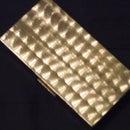Introduction: Four Flap Pecan Graft.
I have been grafting for 20 years, mostly on pecan trees for production of bigger, better nuts. Have also grafted apple, cheery and pear trees to improve the fruit. I have grafted mulberry to make them into fruitless mulberry. The method I have had the most success with is the four flap graft. It is used on small trunks or branches of about 1/2" or less.
Anyone selling you "giant pecan seeds" so you can raise your own pecans just like the ones they are selling you is either ignorant or lying to you. When you plant a pecan, you never know what kind and size of a pecan that tree will produce, and you have to wait 20 to 30 years before you know. The solution is to plant pecans of any size and variety and then graft them when they get up to about 1/2" diameter. Plant 5 or 6 pecans at each location in the late fall or early winter in loose damp soil, just below the ground level. If planted too deep, they will not come up. Mark the location so you can find them when they come up in the spring. If more than one comes up, don't worry, you can thin them in a year or two.
Pecan Grafting using the Four Flap method:
Oklahoma State University had bulletins online explaining all the different methods of grafting and a list of vendors selling pecan scions (pecan wood taken from another tree ready to be grafted onto your tree).
Go to this site:
https://www.google.com/search?q=Oklahoma+state+university+pecan+grafting+&oq=oklahoma+state+university&aqs=chrome.0.69i59j69i57.20952j0j7&sourceid=chrome&espv=210&es_sm=91&ie=UTF-8
Anyone selling you "giant pecan seeds" so you can raise your own pecans just like the ones they are selling you is either ignorant or lying to you. When you plant a pecan, you never know what kind and size of a pecan that tree will produce, and you have to wait 20 to 30 years before you know. The solution is to plant pecans of any size and variety and then graft them when they get up to about 1/2" diameter. Plant 5 or 6 pecans at each location in the late fall or early winter in loose damp soil, just below the ground level. If planted too deep, they will not come up. Mark the location so you can find them when they come up in the spring. If more than one comes up, don't worry, you can thin them in a year or two.
Pecan Grafting using the Four Flap method:
Oklahoma State University had bulletins online explaining all the different methods of grafting and a list of vendors selling pecan scions (pecan wood taken from another tree ready to be grafted onto your tree).
Go to this site:
https://www.google.com/search?q=Oklahoma+state+university+pecan+grafting+&oq=oklahoma+state+university&aqs=chrome.0.69i59j69i57.20952j0j7&sourceid=chrome&espv=210&es_sm=91&ie=UTF-8
Step 1:
This is a demo only so I could take better photos.
This is what a little tree is two years old looks like in early June and ready to graft.
This is what a little tree is two years old looks like in early June and ready to graft.
Step 2:
Order or collect the scions in February and keep them in refrigerator in a plastic bag with a damp paper towel until late May or early June.
Carry your scions to the trees in a styrofoam cooler with ice in it to keep them cool.
Try cutting a small limb on a pecan and make sure the bark peels off the wood easily. If not, you are trying to graft too early in the season. It should slip fairly easily.
Cut the tree straight across, with blade side down, on a good smooth spot with no branches or defects within 2" of bottom of the cut. Try to work in the shade and do not touch the cambium (that's the green part below the bark and above the wood.) Try to work as quickly as possible so the scion and the tree's cambium does not dry out.
Carry your scions to the trees in a styrofoam cooler with ice in it to keep them cool.
Try cutting a small limb on a pecan and make sure the bark peels off the wood easily. If not, you are trying to graft too early in the season. It should slip fairly easily.
Cut the tree straight across, with blade side down, on a good smooth spot with no branches or defects within 2" of bottom of the cut. Try to work in the shade and do not touch the cambium (that's the green part below the bark and above the wood.) Try to work as quickly as possible so the scion and the tree's cambium does not dry out.
Step 3:
Cut off the bottom of the scion to insure fresh cambium.
Cut four tapered pieces off the bottom of the scion leaving a little cambium towards the end.
DO NOT TOUCH CAMBIUM
Cut four tapered pieces off the bottom of the scion leaving a little cambium towards the end.
DO NOT TOUCH CAMBIUM
Step 4:
Make an X on top of the tree.
Peel back the bark and cambium about 1.25", but do not touch it other than with your thumb nail.
Peel back the bark and cambium about 1.25", but do not touch it other than with your thumb nail.
Step 5:
Cut the wood off the top of the tree, at the bottom of the flaps.
Step 6:
Insert the scion and wrap a small piece of masking tape around the flaps, holding them against the scion.
Wrap the joint very tightly with electrical tape, preferably white tape.
Black tape will heat up under the summer sun, ruining the graft.
If you MUST use black tape, wrap it with aluminum foil over the black tape.
Apply the wrap well above and below the graft, ensuring it is airtight.
I sometimes use masking tape over the black tape, but I am retired
and am out among my 200 pecan trees nearly everyday.
One disadvantage in using electrical tape is that you MUST slit down vertically
through the tape with a sharp blade the following year to release the tape.
Do not peel it off, just slit it vertically, and it will fall off in a week or so.
I always tie on a small piece of wood, extending from below the graft to a few inches above the graft. This serves two purposes; it keeps the wind from breaking it off as it starts growing and it keeps the birds from breaking it off.
Wrap the joint very tightly with electrical tape, preferably white tape.
Black tape will heat up under the summer sun, ruining the graft.
If you MUST use black tape, wrap it with aluminum foil over the black tape.
Apply the wrap well above and below the graft, ensuring it is airtight.
I sometimes use masking tape over the black tape, but I am retired
and am out among my 200 pecan trees nearly everyday.
One disadvantage in using electrical tape is that you MUST slit down vertically
through the tape with a sharp blade the following year to release the tape.
Do not peel it off, just slit it vertically, and it will fall off in a week or so.
I always tie on a small piece of wood, extending from below the graft to a few inches above the graft. This serves two purposes; it keeps the wind from breaking it off as it starts growing and it keeps the birds from breaking it off.
Step 7:
One curious fact about grafting pecans is that a tree that is not grafted takes 20 to 30 years to bear pecans. If you graft it, the graft sometimes bears pecans the first year.
When you graft a scion onto a bigger tree, the buds start growing and will grow 10 feet tall the first year, causing them to break off if not pruned and / or braced up somehow.
Grafting is well worth the effort. I first started grafting after planting some pecan trees, waiting 20 years, only to find the first pecans were the diameter of my little finger. The first Photo shows a pecan from an un-grafted tree and one from a grafted tree. These photos were taken when they had the husk on them. They are smaller when they shed the husk. Needless to ask, but which would you rather crack enough to make a pecan pie?
The last photo shows 3 grafts made about 10 years ago. I had 2 trees in the front yard,each about 6 inches in diameter and 20 feet tall. I sawed one off about 8 feet from the ground and put 3 bark grafts on it My wife didn't want me to touch the other one. Within 2 years, it was back to the same height as the other one. She later let me graft the other one.
A bark graft is done on big trees and requires sawing off the tree , making it look like a fence post. They recover quickly.

Participated in the
Workshop Contest











